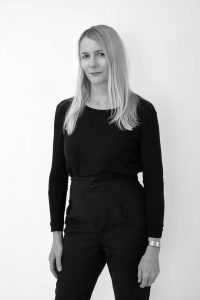Katja Bergers artistic biography was initiated by a strong interest in photography, which she has been intensively pursuing from the very beginning. Apart from her extensive, deep studies of analog photography, she additionally starts to devote herself to painting and calligraphy in the 2000s.
by Verena Konrad
By means of a combination of those 3 elements of creative dedication the autodidactic artist develops her very unique approach of artistically self-expression, which is characterized by a pastose color application, strong colors, swinging lines and a flowing expressive style. Her motives derive from a collective memory of images from European art.
In her collages she collects visual statements from cultural history, history of art, fashion, trash, culture of daily life and adds on typographic elements placed in the background or forefront in order to accentuate or negate the proposition of her artwork.
Therefore the collage as such is not a completely new tool for Katja Bergers artistic expression. However in the past collages were applied as integral parts in her compositions only, whereas lately they are transforming into independent pieces of art by themselves.
Hannah Höch, known as the pioneer of modern art and mastermind of the photo-collage, commented on this evolving way of picture production and language in the 20th century as following: “I try to exploit the photo”.
The collages of Katja Berger follow this role model from the aesthetic point of view. Scissors turn into the most important tool of the artist. Book covers and collected picture material, partly from her own photo production, transport her statements. Texts and pictures correlate, form new messages, create controversy and may stimulate revolutionary mental leaps in the eye of the observers.
Katja Berger collects newspapers, photos, old books and starts to clip and rearrange them to create and build up new artworks – desynchronizations of town portraits, socio-historical papers, fashion reports, typographies. The industrial aesthetics of the respective age reunite with figurines taken out of scale and context. Completely innovative constructs emerge, generating versatile social questions on topics such as life, survival, the position of human beings in their ambience and the human norm.
Katja Bergers künstlerische Biographie beginnt mit einem Interesse für Fotografie, dem sie schon früh nachgeht. Zur Beschäftigung mit analoger Fotografie kommen in den 2000er Jahren Malerei und Kalligraphie dazu. Aus diesen drei Elementen entwickelt die freischaffende Künstlerin autodidakt eine eigene Bildsprache, die geleitet ist von einem expressiven Duktus, pastosem Farbauftrag, kräftigen Farben, schwungvollen Linien. Ihre Motive stammen aus dem kollektiven Bildgedächtnis europäischer Kultur. Über die Collage sammelt sie visuelle Statements aus Kultur- und Kunstgeschichte, Mode, Trash und Alltagskultur und versetzt diese mit typografischen Elementen, die manchmal im Hintergrund, manchmal im Vordergrund platziert werden um die Bildaussage so zu unterstreichen oder aber auch zu kontrastieren.
von Verena Konrad
Neu ist die Collage in Katja Bergers Arbeit also nicht. War sie bisher Teil von Bildkompositionen, so wird sie nun eigenständig. „Ich versuche das Foto auszubeuten“ hat Hannah Höch, Pionierin der Moderne und Meisterin der Fotocollage, einer damals zu Beginn des 20. Jahrhunderts völlig neuen Form der Bildproduktion- und sprache, einmal formuliert. Die Klebebilder von Katja Berger folgen zumindest ästhetisch diesem Vorbild. Die Schere wird zum wichtigsten Werkzeug, Buchdeckel und gefundenes Bildmaterial, teils aus eigener Fotoproduktion, tragen Bildaussagen in sich. Text und Bild korrelieren, formen neue Aussagen, widersprechen sich auch manchmal, regen immer zu neuen Gedankensprüngen an.
Katja Berger sammelt Zeitungen, Fotos, alte Bücher und beginnt diese auszuschneiden, neu anzuordnen und so Bilder aufzubauen – Versatzstücke aus Stadtportraits, soziohistorischen Abhandlungen, Modestrecken und Typografie. Industrieästhetik der jeweiligen Zeit, trifft auf im Maßstab verzerrte Figuren aus ganz anderen Kontexten. Was dadurch entsteht, sind völlig neue Konstrukte, die gesellschatliche Fragestellungen aufreißen: nach dem guten Leben, dem Überleben, dem Platz von Menschen in ihrer Umgebung, dem menschlichen Maßstab.
